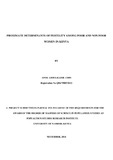| dc.description.abstract | The general objective of the study was to examine the role of the proximate determinants of fertility inhibiting
effects among the poor and non poor in Kenya over the period 2003 to 2008/09. It sought to determine the
fertility inhibiting effect of each of the principal proximate determinants of fertility to change in TFR. The
study is based on the analysis of secondary data obtained from the Kenya Demographic and Health Surveys
(KDHS) of 2003 and 2008/09. The study used Bongaarts model of proximate determinants of fertility as the
main method of data analysis. The variables selected in the study included contraceptive use, postpartum
infecundibility, proportion married and sterility. The findings are analyzed using three socio economic
characteristic of educational level, region and residence. Due to lack of data, induced abortion was not
assessed in the study. The computation procedures are first used to estimate the four indexes of contraceptive
use, postpartum infecundibility, proportion married and sterility to measure the inhibiting effect. Second, TFR
is estimated using the Bongaarts Fertility Model. Lastly, the indexes are decomposed to determine the
contribution made by each of the proximate determinants to be observed change in fertility.
The study indicates that TFR among poor and non poor women declined by 22.2% and 1.2%, respectively. It
was found that fertility declined among poor women mostly due to a 15.4% decline in marriage patterns, a
4.5% decline as a result in increase in contraceptive use and a 3.8% decline due to lengthening of the duration
of postpartum infecundability. For the non poor women fertility declined due to a 4.0 %increase in marriage
pattern, a 3.5% increase due to decrease in contraceptives use and a 8.5% decrease as a result of lengthening
of the duration of postpartum infecundability. The increase in contraceptives use among the poor women
contributed 20% while the decrease in contraceptives use among non poor contributed more than twice to the
decrease in fertility. Marriage patterns contributed 69.0% of the decline in TFR among poor women and more
than three times to the decrease of fertility among non poor women.
Across the regions comparison, Total Fertility Rate (TFR) among poor women declined only in Central and
North Eastern Provinces. Among the non poor, fertility declined in all the Provinces except Coast Province
where the increase was marginal and Eastern Province where TFR remained the same. The increase in fertility
in Coast Province can be attributed to the change in marriage pattern by 21.6% and the shortening of the
duration of postpartum infecundability by 2.3%. However, the increase in contraceptive use contributed to the
decline in TFR by 8.8% to offset partly the increase in marriage pattern and postpartum infecundability.
Among the poor and non poor women, Nyanza and North Eastern Provinces had the highest decline in TFR of
35.0% over the two periods.......................................................................... | en_US |

